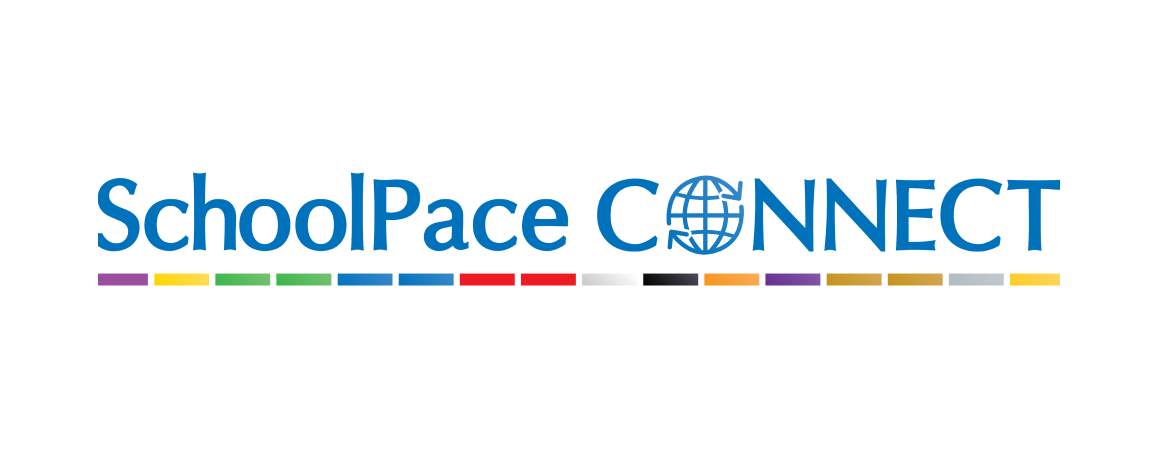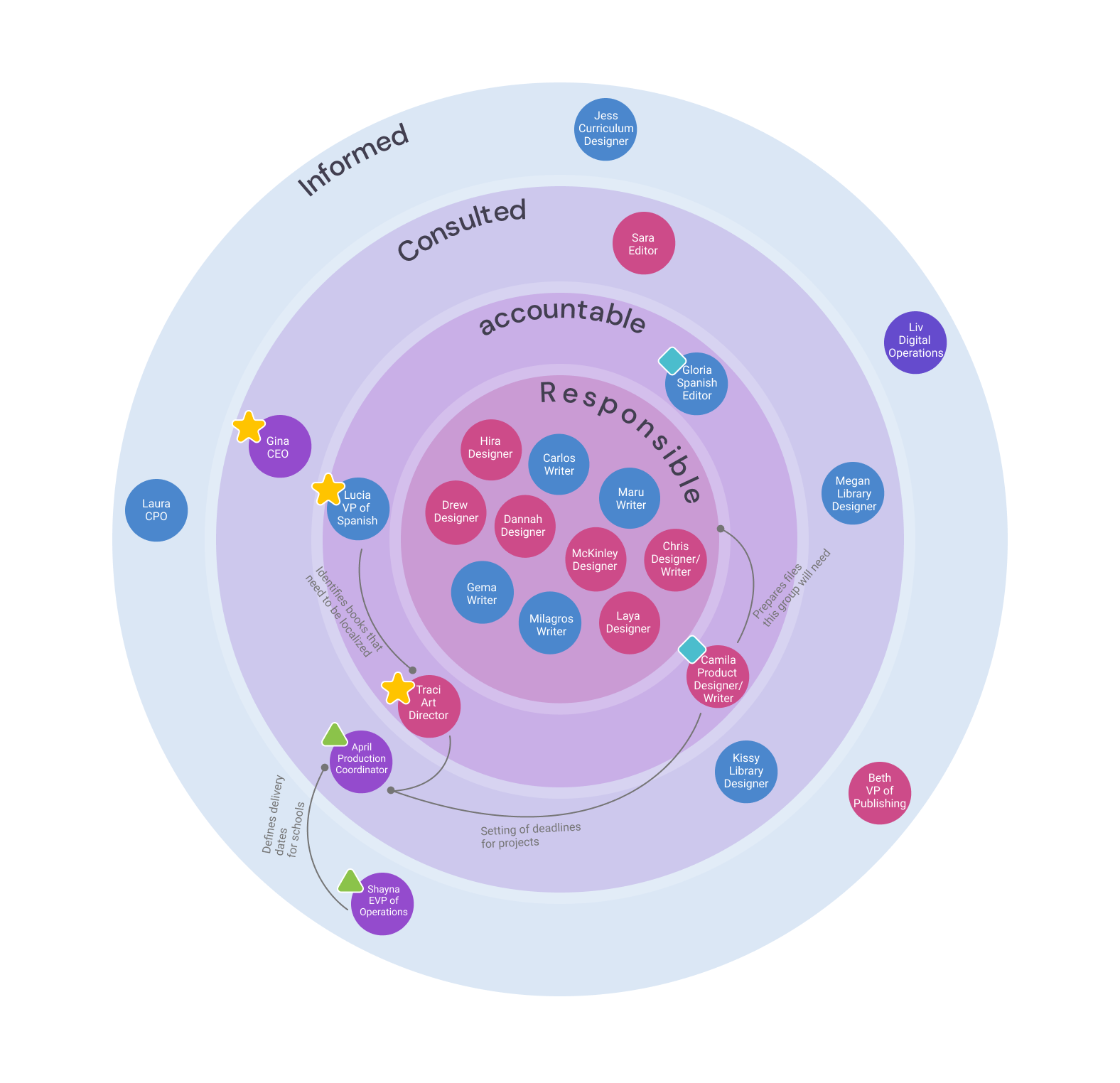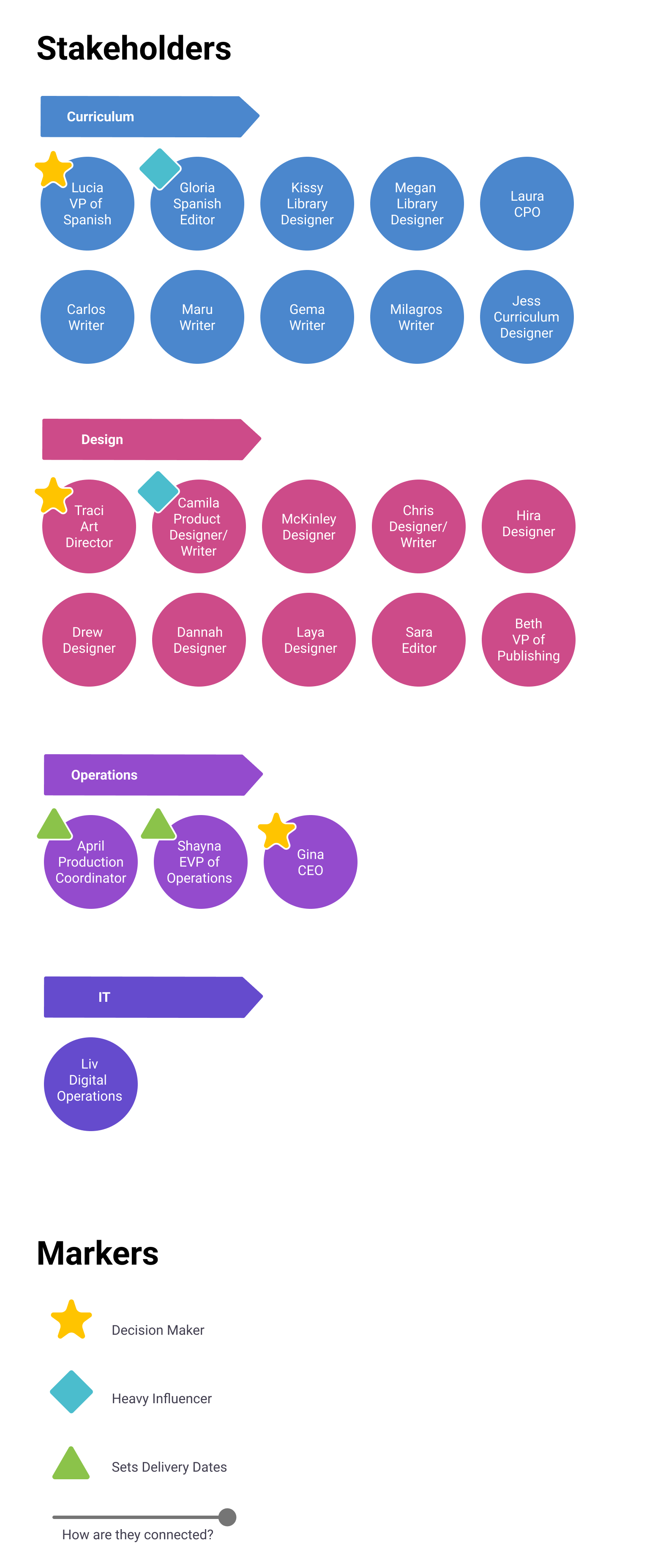Growing the book publishing business by 525% for 1.5 million bilingual students.
Summary
For over 25 years American Reading Company has been a pioneer in bilingual education. Starting in 2018,
I took ownership of the service design initiative that enabled to company to increase their Spanish book production by 525%, and establish themselves as the only education company that can offer English and Spanish materials in equal parts.
🤔 Who is ARC?
American Reading Company (ARC) provides language arts solutions in English and Spanish K-12, in the pursuit of literacy and educational excellence for all students. ARC discovered that too many students were not yet reading at grade level and they, their teachers, and their parents were unsure of how to fix it. The 2022 NAEP results indicate that not only does the reading crisis in the U.S. persist, students performing at the lowest levels continue to fall further behind their peers.
ARC works with 500 schools and districts across all 50 states, reaching 1.5 million students with digital literacy platforms. These platforms are:
🧱Building Blocks from Within
ARC is the only company with a curriculum equipped to fulfill the need of 1:1 parity between English and Spanish, offering materials like books or other education resources in both languages.
Internally ARC has several departments that together create the content needed to feed the literacy platforms. Next we will mention the departments that are the powerhouse of the company, while there are 3 mentioned, we will focus on the later too as they are directly involved with the creation of written materials:
Teaching and Learning (T&I): Gives career coaching to educators and makes sure the teaching methods of the company are being followed in school districts. They are also in charge of keeping data on the school’s overall progress.
ARC Press: Internal publishing house of the company. Designs the books written by C&I, and often aids with the writing and editing of books to keep up with English language demand. Every book written internally, regardless of department of origin, will be labeled as printed under this publisher.
Curriculum and Instruction (C&I): Designs the frameworks for teaching, activities for the classrooms and assessment activities for students. They also write and edit the manuscripts for new books and decide the books that go to each classroom in every school district.
The company works with 250 publishing partners in English and 60 in Spanish. On top of that, as of Q4 of 2023, and with the help of C&I and ARC Press, more than 900 books have been written in English and Spanish. ARC Press products are designed for early readers and illustrated with bold, engaging images. Regardless of age or first language, ARC Press books bridge the gap between book read-alouds and students reading independently.
ARC Press, as a publishing house, is also a tool used by American Reading Company to upkeep 3 main goals, maintaining margins to offer the best price possible to schools districts, helping in furthering the 1:1 parity efforts between English and Spanish when it comes to content offered, and helping in filling gaps when it comes to outdated, unavailable and non diverse books.
💁♀️Background
ARC built its business on selling yearly digital subscriptions to products such as systems to track the learning process of students, games to aid learning, and access to the material library in English and Spanish. Additionally, ARC sells physical materials that go into every classroom, including physical books, reading assessments, and materials for teachers and students to work on.
Due to its ability to create books internally, ARC Press can maintain healthy margins and provide the best pricing possible, and stay competitive in the market. Since the internal publishing house’s inception in 2005, the company specializes in writing books that fill gaps in the market, and add context to topics for a modern audience.
⚖️Legal Requirements
Three states including Texas, Colorado, and California have legal requirements for bilingual education with dozens more that promote it at the discretion of the school district. This is fundamentally what triggered ARC’s interest in using the Spanish content they were already providing, and amplifying it to better take a hold of those very significant markets. If a school works with ARC Press, they receive 8,930 different books, in both English and Spanish K-5.
Out of that amount, since the creation of ARC Press in 2005 to 2018 a total of 722 books were created to replace products from external vendors. From those books 478 in English and 244 in Spanish. Since then, 475 new books have been printed and the full parity of English and Spanish internal products have been met. However, the end goal for ARC Press is to be able to internally print 50% of these books, totaling to 4,465 in all, and this is projected to happen within the next 5 to 8 years.
🫤Lack of Structure
Prior to the bi-literacy legislation in various states enacted starting in 2011, ARC’s focus was limited towards books written in English. With more states requiring materials written in both languages, ARC had a goal to bring Spanish materials up to 1:1 standard. This required hiring significantly more bilingual writers, which took the staff of Spanish writers from 1 to 10.
An influx of newly hired writers, meant that ARC had to analyze the on-boarding process, or rather, the lack thereof. Writers not only needed to learn how the company was operating, but also how ARC Press treated “localization”, or the practice of adapting a product to meet the needs of a particular language, culture and desired population’s “look-and-feel”. Unfortunately, while the writers could fulfill their localization standards for projects of the size they were managing, the company was growing, and the practices were not scalable now that the writer staff grew by tenfold.
The localization process was disjointed, and very informal. To get a book translated from English to Spanish, a writer from C&I translated the material, and sent it off to the VP of Spanish to edit, and humanized the text with the localization standards. The problem was that the VP was the sole reviewer, and quite often, the sole contributor to the entire process, with documentation and process stored away only in scattered notes.
With this in mind, at the time of giving all the localized text to the designers of ARC Press, there was a faulty hand off process. If the company wanted to translate books regularly, changes had to be made, as many parts of the process were held by only one person thus leaving giant gaps of knowledge for everyone else. Neither ARC Press or C&I were very sure about the details of who owned which part of the process, this led to a back and forth between departments taking a very long time, and ultimately this led to books taking anywhere from 3-6 months to get published, totaling about 6 books per year at most. Change needed to happen desperately, not only because this broken and stagnant process meant wasting company’s time and money, but this was also fracturing the timeline to achieve 1:1 language parity.
💔The Problem
How can we enhance the service experience and efficiency in the process of publishing books in Spanish?
What are the pain points that need to be addressed in order to streamline the Spanish book publishing process for enhanced efficiency?
❤️🩹The process
🔸User experience research
To begin the process, I outlined UX research goals and questions I had. I mainly focused on 2 things:
1️⃣ Identifying the stakeholders and conducting user research
2️⃣ Analyzing the understanding of the process from said stakeholders.
🔸Stakeholder interviews and mapping
Due to the lack of organization, and understanding of the company structure, many of my colleagues didn’t understand who was responsible for what. I began by conducting stakeholder interviews to understand the process, identify areas of improvement, and familiarize myself with their subject matter expertise.
I highlighted areas of the company that I wanted to familiarize myself with, including publishing, translating, and strategy areas. Some colleagues were individual contributors (almost like one member departments), and some were connectors, sitting central to multiple various teams. I spoke to:
👩💼 VP of Spanish - Created the assessment system for Spanish readers, supervised the creation of Spanish classroom learning materials and translated and edited most of the Spanish books written internally.
🕵️♀️ Library Designers - responsible for creating the bundle of books going to every classroom to support and aid the Spanish learning materials.
👩🏫 Curriculum Designers - Created the learning materials for classrooms and specified the topics that would need books to support them for the library designers.
👩🎨 Art Director - Oversaw the design of English and Spanish books as well as the editing for English books.
👩💻 Book Designers - created cover and guts for books in English as well as the formatting of books in Spanish to add the translated text.
👩🔧 Operations Lead - Defined timelines that needed to be met in order to be able to send the books to classrooms in a timely manner.
Interviews lasted 30 minutes each, and I focused on an array of questions including:
✏︎ While our departments coexist when it comes to our products, I don’t believe we’ve had the opportunity to work together before. Can you tell me a little bit about your role?
✏︎ What is your current role here at ARC?
✏︎ What are the most critical needs and goals for your role?
✏︎ What challenges are present with the current state of Spanish catalog?
✏︎ What does success look like in the next year when it comes to English to Spanish parity?
✏︎ What are our key performance indicators (KPIs) for measuring this process' quality and success?
✏︎ Describe to be the process of translation in your department
✏︎ Can you tell me about any solutions to this problem you’ve tried before?
✏︎ What is your preferred communication method? How do you keep record of progress in your projects currently?
🔸I learned that:
1️⃣ Every stakeholder had either a truncated understanding of the process, or had their own unique process when it came to publishing books in Spanish.
2️⃣ While the goal of the books was clear in the minds of the people that need them the most, the process of how these books came to be ready wasn’t as clear.
3️⃣ Stakeholders did not know which person was responsible for various parts of the process.
⚙️The re-design
🔸Creating a Rubric (The product)
Initially the process was very physical, by this I mean, it involved several printed materials. It involved a printed checklist along with a printed draft of the book where notes and corrections were added by various team members. Because the process was so high-touch, book drafts would get lost, damaged or misplaced as they also occupied a lot of space, and it was hard to get an overview of the number of documents being worked on at the same time.
As the business began to scale, and as more school districts demanded digital copies of Spanish and English books, we had to quickly pivot into a digitization of the process to save time, to cut costs, to support our remote staff, and to deliver books at a speedier turnaround.
I adjusted the entire process to a digital environment which involved the integration of task boards to replace the checklist and digital access to the books for formatting, notes and corrections. Now, the staff could clearly pinpoint what part of the process a specific draft was on, how many further steps were left, and could articulate when the book would be finalized.
🔸Localization and translation
Translating a book is a deceptively difficult process. It seems simple, to take words from English, quickly run them through Google translate, and boom- we are finished! If only it were so simple.
“Localization”, or in other words a user-centric, thoughtful, empathetic translation takes into account :
ARC Press had some challenges to consider, including creating a uniform content strategy, which would allow it to both consistently meet publishing deadlines, and accelerate the creation of Spanish content to the same amount as English.
🔸Content strategy and information hierarchy
It was very important to consider various aspects of localization, and the content strategy. We were creating books for a very specific user audience and had to be thoughtful about the way they interpret, comprehend, and learn. The general areas of focus were:
Focus on Spanish - Spanish, but from where?
✏︎ There are 10 dialects of Spanish with their own regional variances. Translators and ARC Press had to commit to an agreed-upon dialect of choice, focusing on a neutral, academic Mexican Spanish tone.
✏︎ The translators were encouraged to keep the joy of the Spanish language, through catering to its diversity. Books kept “Fun Fact” sections, teaching the children of all the different forms a word can take depending on the region in Latin America.
➡️ Example of localization that caused quite a stir! This book uses the word banana in English several times, so for its Spanish counterpart we had to discuss and decide, what term for banana we would chose from all the different ways to say it in Latin America.
➡️
⬆️ We ended up adding a small section towards the back mentioning all the different ways to do it, and this was a tool we implemented for several other books after this case.
🔸Information Architecture
✏︎ With consideration of words expanding and contracting through translation, I had to be thoughtful about IA and hierarchy with regards to how readers comprehend the translations, as well as the placement of the words on physical and digital re-prints of the book.
✏︎ The size of the font choice was 13pt or higher for accessibility, and these were standards already existent for the English books, from conducting reviews to adhere to IA parameters
🔸Voice and Tone
✏︎ The voice talking to the children has to be friendly, so as to make them feel supported and never judged in their learning journey. Using “usted” would be too formal and it could make them feel judged or anxious. We wanted to always foster a welcoming environment for them to learn comfortably and at their pace.
✏︎ ARC Press had to be thoughtful of cognitive load for children’s learning. There were instances where a one to one translation would make the words too advanced and lengthy to be decodable, meaning children would lose interest, or feel frustrated by the words.
🔸Testing and Analytics
After we utilized the rubric for roughly three projects (3 months), I led retrospective to review and analyze:
✏︎ What aspects of the rubric were helpful
✏︎ What aspects needed improvement, and further iteration
✏︎ Whether the order of steps in process made sense for stakeholders and users
I received feedback from stakeholders, and made improvements, namely:
1️⃣ Taking out the “revisions #2” section, as those first 3 steps should be addressed before the initial script approval. Checking the reading difficulty of the book, grammar and fact checking should all be done before the editor revises the text.
2️⃣ The approval check after “Book corrections #2” was removed also, as it would be more beneficial to review the file once the books have been fully formatted by ARC Press.
3️⃣ More than the steps getting adjusted, getting feedback was a very useful way to understand what the staff considered the process of localization looked like.
🔸Digitization post COVID
Initially the process was very physical, by this I mean, it involved several printed materials. It involved a printed checklist along with a printed draft of the book where notes and corrections were added by various team members. Because the process was so high-touch, book drafts would get lost, damaged or misplaced as they also occupied a lot of space, and it was hard to get an overview of the number of documents being worked on at the same time.
As the business began to scale, and as more school districts demanded digital copies of Spanish and English books, we had to quickly pivot into a digitization of the process to save time, to cut costs, to support our remote staff, and to deliver books at a speedier turnaround.
I adjusted the entire process to a digital environment which involved the integration of task boards to replace the checklist and digital access to the books for formatting, notes and corrections. Now, the staff could clearly pinpoint what part of the process a specific draft was on, how many further steps were left, and could articulate when the book would be finalized.
🔸Improving the Long-term, Documentation and Education
After three months of utilizing the rubric, testing and iterating, I came up with a new process to launch translated books. It was getting progressively difficult to keep up with the projects in a printed format, and due to the size of the team now, moving the process to a digital format would make keeping track of things easier, faster and more readily accessible to everyone. Feedback was frequently considered, and staff had chances to be trained and supported on the new process.
🙌The Results
When the process redesign began, ARC Press had a significant challenge across its whole company. Factors like COVID and state legislation gave the company and opportunity to become the sole and primary curriculum developer to offer products digitally and bilingually (in English and Spanish).
After conducting UX research, pinpointing the blockers and opportunities, and iterating on various methods for the process to take place, I created the digital dashboard for the company to utilize.
The dashboard answered for errors and challenges the company had with printed rubrics, to-dos, and other ways that the process was managed.
The dashboard demonstrated:
✏︎ All of the books being worked on
✏︎ The place in the process of individual books
✏︎ The stakeholders responsible for each part of the process
✏︎ Labels for books from the same group (instances)
My process opened the gate to new translators to aid the highly overworked VP of Spanish and increased Spanish book production exponentially. It also made translators aware of each other and the design team which led to the creation of the MLT (multilingual team), which was a space to discuss best translation practices, doubts and best experiences that could benefit the communication across departments and the process.
Before the dashboard there was no structure or proper documentation of the process. Teams would take notes for their references but that wasn't necessarily standardized information shared across the board. It was almost like the departments involved were working in silos, deadlines were not clear, delegation of tasks to team members was scarce and this caused a very fragmented delivery of the final product.
ARC Press now had a clear process with clear deadlines, and clear expectations. The company could now effectively and consistently march toward its goal of one-to-one parity of all of their English to Spanish products.
As a result, the Dashboard process saved the company $38.5 million, and increased the bilingual book production by 525% from 2018 to 2023 in English and Spanish. The cost-cutting measures came in the form of ARC Press:
1️⃣ Being able to print books in-house, cutting margins
2️⃣ Replacing expensive books and lowering the purchase from over 60 international vendors
3️⃣ Being able to consistently, and on a timely basis print more books
4️⃣ Being able to train and keep staff, creating less friction, and turnover














